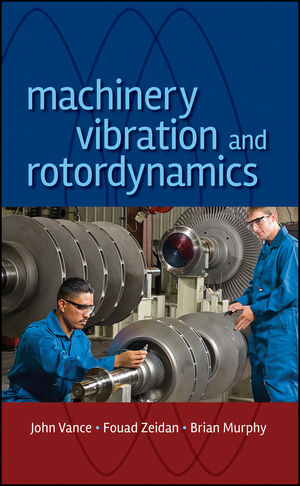|
Textbook
Machinery Vibration and RotordynamicsISBN: 978-0-471-46213-2
Hardcover
416 pages
May 2010, ©2010
 |
||||||
1 Fundamentals of Machine Vibration and Classical Solutions.
The Main Sources of Vibration in Machinery.
The Single Degree of Freedom (SDOF) Model.
Using Simple Models for Analysis and Diagnostics.
Six Techniques for Solving Vibration Problems with Forced Excitation.
Some Examples with Forced Excitation.
Illustrative Example 1.
Illustrative Example 2.
Illustrative Example 3.
Illustrative Example 4.
Some Observations about Modeling.
Unstable Vibration.
References.
Exercises.
2 Torsional Vibration.
Torsional Vibration Indicators.
Objectives of Torsional Vibration Analysis.
Simplified Models.
Computer Models.
Kinetic Energy Expression.
Potential Energy.
Torsional Vibration Measurement.
French’s Comparison Experiments.
Strain Gages.
Carrier Signal Transducers.
Frequency-modulated Systems.
Amplitude-modulated Systems.
Frequency Analysis and the Sideband System.
French’s Test Procedure and Results.
A Special Tape for Optical Transducers.
Time-interval Measurement Systems.
Results from Toram’s Method.
Results from the Barrios/Darlow Method.
References.
Exercises.
3 Introduction to Rotordynamics Analysis.
Objectives of Rotordynamics Analysis.
The Spring–Mass Model.
Synchronous and Nonsynchronous Whirl.
Analysis of the Jeffcott Rotor.
Polar Coordinates.
Cartesian Coordinates.
Physical Significance of the Solutions.
Three Ways to Reduce Synchronous Whirl Amplitudes.
Some Damping Definitions.
The "Gravity Critical".
Critical Speed Definitions.
Effect of Flexible (Soft) Supports.
Rotordynamic Effects of the Force Coefficients—A Summary.
The Direct Coefficients.
The Cross-coupled Coefficients.
Rotordynamic Instability.
Effect of Cross-Coupled Stiffness on Unbalance Response.
Added Complexities.
Gyroscopic Effects.
Effect of Support Asymmetry on Synchronous Whirl.
False Instabilities.
References.
Exercises.
4 Computer Simulations of Rotordynamics.
Different Types of Models.
Bearing and Seal Matrices.
Torsional and Axial Models.
Different Types of Analyses.
Eigenanalysis.
Linear Forced Response (LFR).
Transient Response.
Shaft Modeling Recommendations.
How Many Elements.
45-Degree Rule.
Interference Fits.
Laminations.
Trunnions.
Impeller Inertias via CAD Software.
Stations for Added Weights.
Rap Test Verification of Models.
Stations for Bearings and Seals.
Flexible Couplings.
Example Simulations.
Damped Natural Frequency Map (NDF).
Modal Damping Map.
Root Locus Map.
Undamped Critical Speed Map.
Mode Shapes.
Bode/Polar Response Plot.
Orbit Response Plot.
Bearing Load Response Plot.
Operating Deflected Shape (ODS).
Housing Vibration (ips and g’s).
References.
5 Bearings and Their Effect on Rotordynamics.
Fluid Film Bearings.
Fixed-geometry Sleeve Bearings.
Variable-geometry Tilting Pad Bearings.
Fluid Film Bearing Dynamic Coefficients and Methods of Obtaining Them.
Load Between Pivots Versus Load on Pivot.
Influence of Preload on the Dynamic Coefficients in Tilt Pad Bearings.
Influence of the Bearing Length or Pad Length.
Influence of the Pivot Offset.
Influence of the Number of Pads.
Ball and Rolling Element Bearings.
Case Study: Bearing Support Design for a Rocket Engine Turbopump.
Ball Bearing Stiffness Measurements.
Wire Mesh Damper Experiments and Computer Simulations.
Squeeze Film Dampers.
Squeeze Film Damper without a Centering Spring.
O-ring Supported Dampers.
Squirrel Cage Supported Dampers.
Integral Squeeze Film Dampers.
Squeeze Film Damper Rotordynamic Force Coefficients.
Applications of Squeeze Film Dampers.
Optimization for Improving Stability in a Centrifugal Process Compressor.
Using Dampers to Improve the Synchronous Response.
Using the Damper to Shift a Critical Speed or a Resonance.
Insights into the Rotor–Bearing Dynamic Interaction with Soft/Stiff Bearing Supports.
Influence on Natural Frequencies with Soft/Stiff Bearing Supports.
Effects of Mass Distribution on the Critical Speeds with Soft/Stiff Bearing Supports.
Influence of Overhung Mass on Natural Frequencies with Soft/Stiff Supports.
Influence of Gyroscopic Moments on Natural Frequencies with Soft/Stiff Bearing Supports.
References.
Exercises.
Appendix: Shaft With No Added Weight.
6 Fluid Seals and Their Effect on Rotordynamics.
Function and Classification of Seals.
Plain Smooth Seals.
Floating Ring Seals.
Conventional Gas Labyrinth Seals.
Pocket Damper Seals.
Honeycomb Seals.
Hole-pattern Seals.
Brush Seals.
Understanding and Modeling Damper Seal Force Coefficients.
Alford’s Hypothesis of Labyrinth Seal Damping.
Cross-coupled Stiffness Measurements.
Invention of the Pocket Damper Seal.
Pocket Damper Seal Theory.
Rotordynamic Testing of Pocket Damper Seals.
Impedance Measurements of Pocket Damper Seal Force Coefficients (Stiffness and Damping) and Leakage at Low Pressures.
The Fully Partitioned PDS Design.
Effects of Negative Stiffness.
Frequency Dependence of Damper Seals.
Laboratory Measurements of Stiffness and Damping from Pocket Damper Seals at High Pressures.
The Conventional Design.
The Fully Partitioned Design.
Field Experience with Pocket Damper Seals.
Two Back-to-Back Compressor Applications.
Case 1.
Case 2.
A Fully Partitioned Application.
Designing for Desired Force Coefficient Characteristics.
The Conventional PDS Design.
The Fully Partitioned Pocket Damper Seal.
Leakage Considerations.
Some Comparisons of Different Types of Annular Gas Seals.
References.
7 History of Machinery Rotordynamics.
The Foundation Years, 1869–1941.
Shaft Dynamics.
Bearings.
Refining and Expanding the Rotordynamic Model, 1942–1963.
Multistage Compressors and Turbines, Rocket Engine Turbopumps, and Damper Seals, 1964–Present.
Stability Problems with Multistage Centrifugal Compressors.
Kaybob, 1971–72.
Ekofisk, 1974–75.
Subsequent Developments.
New Frontiers of Speed and Power Density with Rocket Engine Turbopumps.
The Space Shuttle Main Engine (SSME).
High-pressure Fuel Turbopump (HPFTP).
Rotordynamic Instability Problem.
Noncontacting Damper Seals.
Shaft Differential Heating (The Morton Effect).
References.
INDEX.



